Kanji for “Now”: 今 (ima)
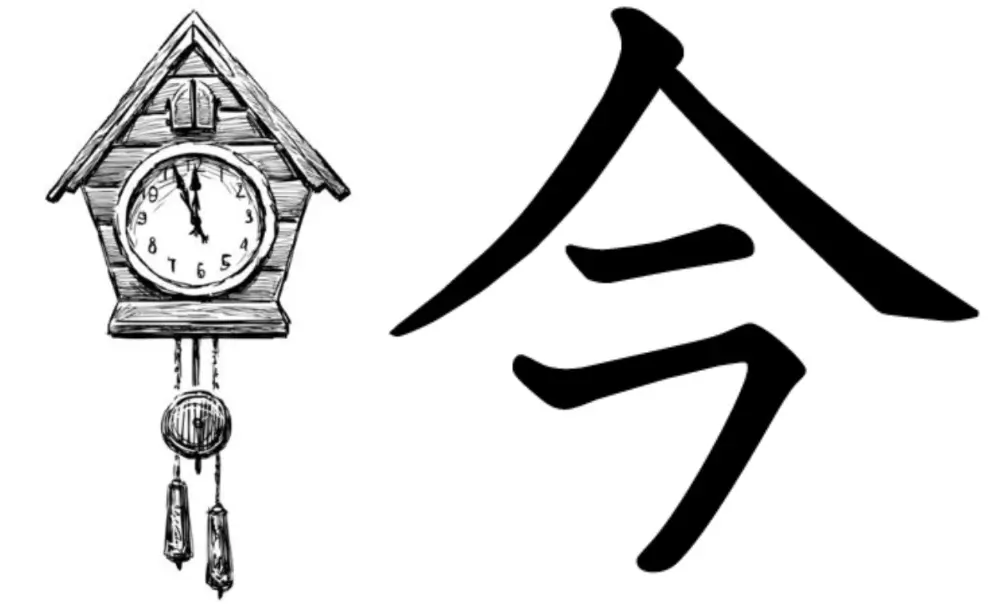
The Japanese Kanji for “Now” is 今.
The kun’yomi (Japanese reading) pronunciation of the Kanji 今 is “ima” (いま), and the on’yomi (Chinese reading) pronunciations of 今 are “kon” (コン) or “kin” (キン).
Apart from the literal meaning of “Now”, the Kanji 今 is also used in the following contexts:
- Current: Used to describe something occurring in or pertaining to the present period.
- Modern: Sometimes used in contrast to past or ancient, referring to modern times or the contemporary era.
The Kanji 今 quite commonly appears in Japanese names and is used in 1395 names. However, in names, it is pronounced as “na” (な).
The Kanji 今 is constructed with 4 strokes. It is part of the JLPT N5 syllabus (please check the list of JLPT N5 Kanji) and is taught in grade 2 in Japanese schools.
Origin of the Shape 今
The following illustration shows the ancient shape of the kanji 今 in Oracle Bone Script, Bronze inscription, small seal script, and how we write it today:
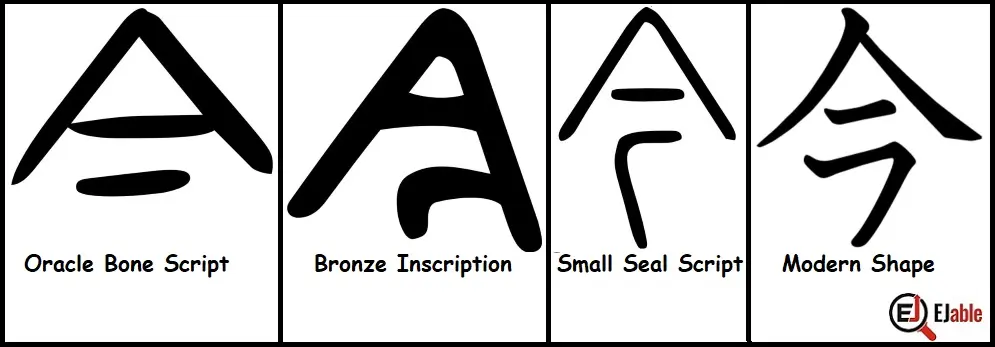

It is believed that the above illustrated ancient shapes of the Kanji 今 depicted a lid or cover along with a stopper for a wine cask or container. However, such interpretations are sometimes guesswork. Moreover, this logic does not associate this shape with its meaning “now.”
Mnemonic 1 to Remember the Kanji 今 Meaning “Now”
As discussed above, neither the ancient shapes of 今 nor the modern shape, or shinjitai, relate this Kanji to its meaning “Now.” Therefore, the following illustrations can make good pictorial mnemonics to relate the shape 今 with its meaning of “Now”:
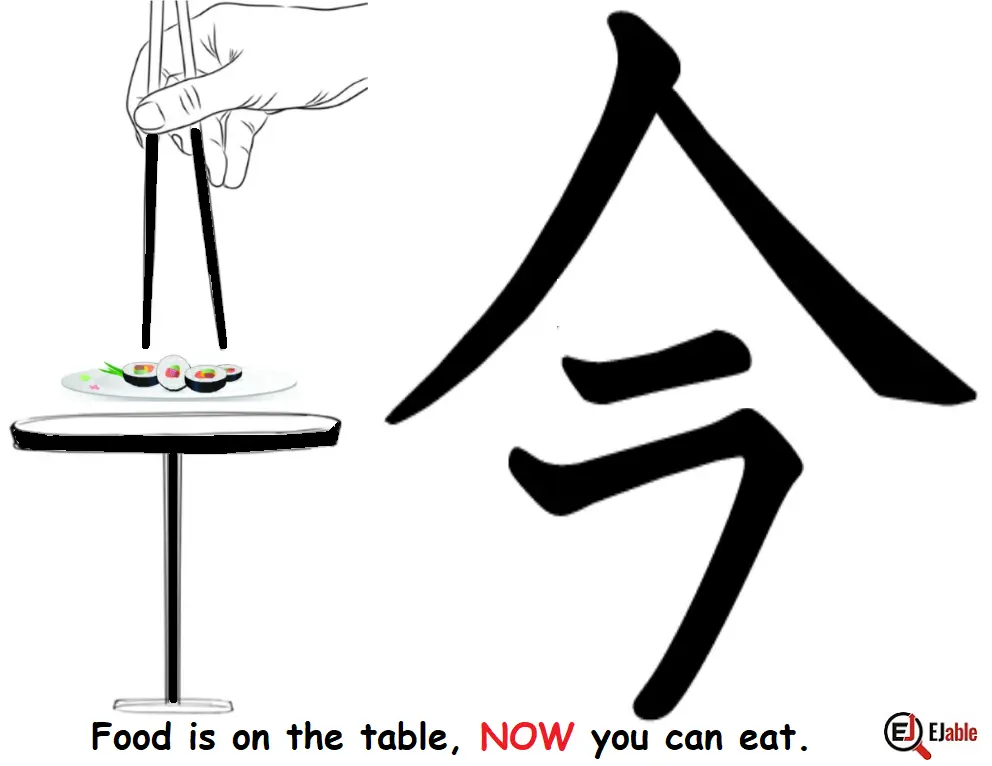

Explanation
Consider the two strokes at the top of the shape, 今 as chopsticks and a table with a plate of food below. You can think of someone saying, “Food is on the table, NOW you can eat.” to associate it with its meaning.
Mnemonic 2 for the Shape 今
Another pictorial mnemonic to remember 今 can be the following illustration, where you can associate this shape with a wall clock with a pendulum:
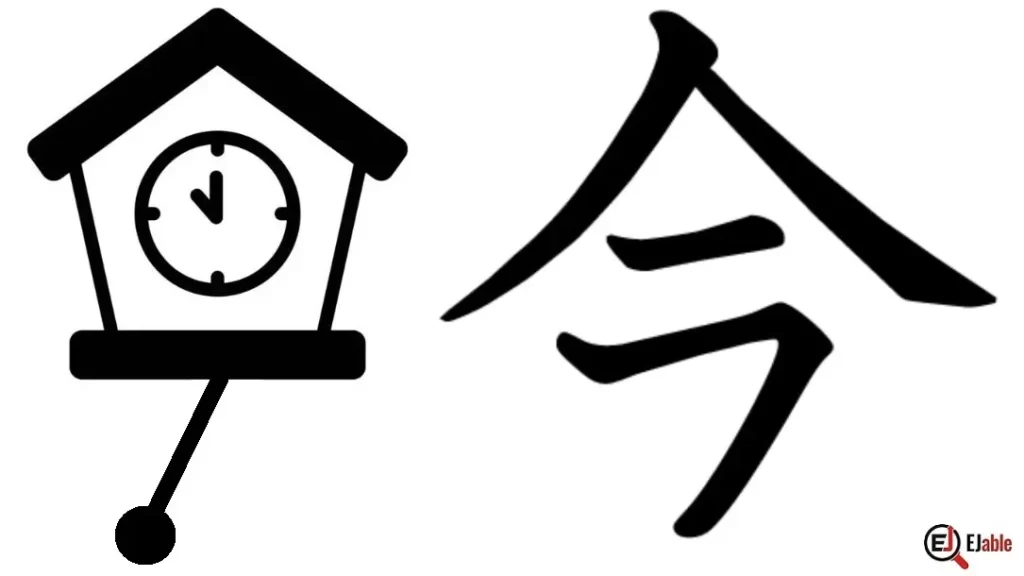

Stroke Order for the Kanji 今
The following illustrations show the order of the 4 strokes to write the Kanji 今:
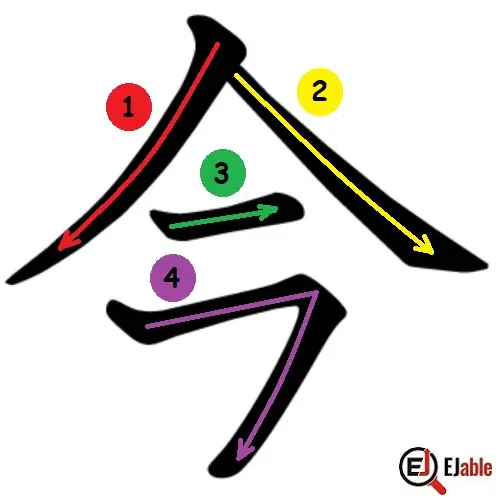

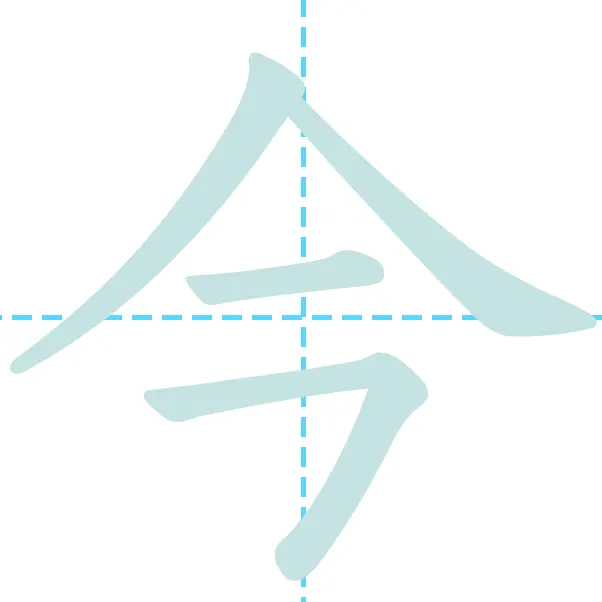

今 as a Component in other Kanji Characters
The Kanji 今 is used as a component in 53 Kanji characters, out of which the following 7 are Jōyō (commonly used) Kanji:
- 念 (ねん / nen): Thought, idea.
- Explanation: 念 combines 心 (heart) with 今 (now), suggesting thoughts or feelings held in the mind currently or persistently.
- 含 (がん / gan): Include, contain.
- Explanation: 含 pairs 口 (mouth) with 今, representing the idea of holding something in the mouth or metaphorically including or containing something in a broader sense.
- 陰 (いん / in): Shade, shadow, negative.
- Explanation: 陰 uses 阝 (the hill or city Kanji radical) with 今, symbolizing what is hidden from the sun, hence in the shade or shadow, often extending metaphorically to imply secrecy or subtlety.
- 琴 (きん / kin): Koto; a traditional Japanese stringed instrument.
- Explanation: The Kanji 琴 combines two 王 (king) with 今, possibly reflecting the precious or cherished status of the instrument, traditionally played in the present moment for enjoyment and artistic expression. The character 今 is merely a phonetic component in this Kanji for its pronunciation, and not the meaning.
- 吟 (ぎん / gin): Chant, recite.
- Explanation: 吟 pairs 口 (mouth) with 今, suggesting the act of reciting or singing with deliberation and depth, often in a poetic context.
- 捻 (ねん / nen): Twist, spin.
- Explanation: The Kanji 捻 combines 扌 (“hand” radical) with 今, depicting the action of twisting or turning something with one’s hands, perhaps suggesting a current action or method.
- 貪 (どん / don): Greed, covet.
- Explanation: 貪 joins 貝 (shell/money) with 今, indicating a strong desire or greed for wealth or material possessions, focusing on the present acquisition.
今 Kanji in Compounded Words
There are 144 Japanese words that begin with the Kanji for “Now” (今), and it appears in 165 words overall.
Examples of Kanji 今 in Compounded Japanese Words
- 今日 (きょう / kyō): Today.
- 今回 (こんかい / konkai): This time, referring to the present or current instance.
- 今後 (こんご / Kongo): From now on, referring to future developments from the present forward.
- 今朝 (けさ / kesa): This morning; the morning of the current day.
- 今晩 (こんばん / konban): Tonight, the evening of the current day.
- 今月 (こんげつ / kongetsu): This month; the current month.
- 今年 (ことし / kotoshi): This year; the current year.
- 今更 (いまさら / imasara): Now of all times; too late; used to express that something is happening now when it seems too late or redundant.
- 今度 (こんど / kondo): This time; next time; often used to refer to an upcoming occasion or a recent past event.
- 今にも (いまにも / imanimo): Any moment now; implies something is about to happen very soon.
- 今すぐ (いますぐ / imasugu): Right now; immediately.
- 今一度 (いまいちど / imaichido): Once more, another time, suggesting a repetition in the near future.
- 今夜 (こんや / konya): Tonight; specifically refers to the night of the current day.
- 今昔 (こんじゃく / konjaku): Past and present, a literary term that compares the old with the new.
- 今日中 (きょうじゅう / kyōjū): By the end of today; within today.
- 今まで (いままで / imamade): Until now; up to the present moment.
- 今回限り (こんかいかぎり / konkai kagiri): Just this once, implying an exception for the current occasion.
- 今後とも (こんごとも / kongotomo): Hereafter as well, a formal expression used to ask for continued support or relationship.
- 今季 (こんき / konki): This season; the current season.
- 今更感 (いまさらかん / imasarakan): A feeling of “it’s too late” or “not again,” often used to describe a sense of redundancy or belated action.
These examples highlight how 今 is used to express immediacy and current relevance, expanding its meaning of “now” across a variety of everyday and formal expressions in Japanese.
Note: Check other Kanji characters on the page “How to Learn Kanji“.


A long-term ex-pat in Japan, Himanshu comes with an IT background in SAP consulting, IT Business Development, and then running the country operations of an IT consulting multinational. Himanshu is the co-founder and Managing Director of ReachExt K.K. and EJable.com. He is also an Advisory Board Member of a Silicon Valley AI/IoT startup.

